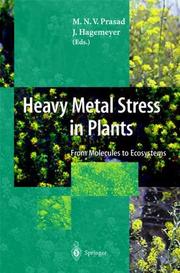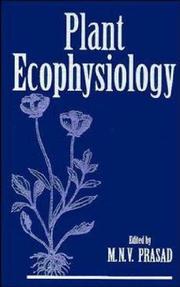| Listing 1 - 10 of 36 | << page >> |
Sort by
|

ISBN: 3540401318 3642072682 3662077434 Year: 2004 Publisher: Berlin ; London : Springer,
Abstract | Keywords | Export | Availability | Bookmark
 Loading...
Loading...Choose an application
- Reference Manager
- EndNote
- RefWorks (Direct export to RefWorks)
Heavy metal phytotoxicity has been known for more than a century. Therefore, it is astonishing that interest in the effects of heavy metals on organisms has been aroused only recently. Research in the past years, however, has confirmed the immense damage by metal pollution to plants, the soil and ultimately to humans. This completely updated and enlarged second edition gives a state-of-the art review on both field and laboratory work. It deals with the various functional and ecological aspects of heavy metal stress on plants and outlines the scope for future research and the possibilities for remediation.
Plants --- Heavy-metal tolerant plants --- Heavy metals --- Métallophytes --- Effect of heavy metals on --- Environmental plants --- ECO Ecology --- ecology --- heavy metals --- physiology --- stress --- Métallophytes --- Environmental plants. --- Plant biochemistry. --- Soil science. --- Soil conservation. --- Ecotoxicology. --- Plant ecology. --- Plant physiology. --- Plant Biochemistry. --- Soil Science & Conservation. --- Plant Ecology. --- Plant Physiology. --- Botany --- Physiology --- Phytoecology --- Vegetation ecology --- Ecology --- Ecotoxicology --- Pollutants --- Pollution --- Environmental health --- Toxicology --- Conservation of soil --- Erosion control, Soil --- Soil erosion --- Soil erosion control --- Soils --- Agricultural conservation --- Soil management --- Pedology (Soil science) --- Agriculture --- Earth sciences --- Phytochemistry --- Plant biochemistry --- Plant chemistry --- Biochemistry --- Phytochemicals --- Plant biochemical genetics --- Control --- Prevention --- Conservation --- Floristic ecology

ISBN: 0824705238 Year: 2001 Publisher: New York : Marcel Dekker,
Abstract | Keywords | Export | Availability | Bookmark
 Loading...
Loading...Choose an application
- Reference Manager
- EndNote
- RefWorks (Direct export to RefWorks)
A summary of data on heavy metal accumulation, biomonitoring, toxicity and tolerance, metal contamination and pollution in the environment, and the importance of biodiversity for environmental monitoring and cleanup of metal-contaminated and polluted ecosystems. It advocates the use of bacteria, mycorrhizae, freshwater algae, salt marshes, bryo- and pteridophytes, angiosperms, constructed wetlands, reed beds, and floating plant systems and tree crops to treat wastewaters and industrial effluents containing toxic heavy metals.
Métal lourd --- Biomonitoring --- Toxicité du sol --- Pollution du sol --- Bioremédiation --- Metals --- Environmental aspects. --- Environmental Sciences and Forestry. Environmental Management --- Agrotechnology and Food Sciences. Toxicology --- Environmental Pollution --- Environmental Toxicology, Ecotoxicology --- Environmental Pollution. --- Environmental Toxicology, Ecotoxicology. --- Heavy metals --- Soil toxicity --- Soil pollution --- Bioremediation.

ISBN: 0471131571 Year: 1997 Publisher: New York John Wiley
Abstract | Keywords | Export | Availability | Bookmark
 Loading...
Loading...Choose an application
- Reference Manager
- EndNote
- RefWorks (Direct export to RefWorks)
ECO Ecology --- UVB radiation --- air pollution --- allelochemicals --- carbon dioxide --- drought stress --- ecology --- fire --- flooding --- freezing --- herbicides --- light --- metals --- plant ecophysiology --- polyamines --- radionuclides --- salt stress --- temperature
Book
ISBN: 0128028726 0128028300 9780128028728 9780128028308 Year: 2016 Publisher: Amsterdam
Abstract | Keywords | Export | Availability | Bookmark
 Loading...
Loading...Choose an application
- Reference Manager
- EndNote
- RefWorks (Direct export to RefWorks)
Bioremediation and Bioeconomy provides a common platform for scientists from various backgrounds to find sustainable solutions to environmental issues, including the ever-growing lack of water resources which are under immense pressure due to land degradation, pollution, population explosion, urbanization, and global economic development. In addition, large amounts of toxic waste have been dispersed in thousands of contaminated sites and bioremediation is emerging as an invaluable tool for environmental clean-up. The book addresses these challenge by presenting innovative and cost-effective solutions to decontaminate polluted environments, including usage of contaminated land and waste water for bioproducts such as natural fibers, biocomposites, and fuels to boost the economy. Users will find a guide that helps scientists from various backgrounds find sustainable solutions to these environmental issues as they address the topical issues crucial for understanding new and innovative approaches for sustainable development.--
Bioremediation. --- Environmental biotechnology --- Biodegradation --- Pollution
Book
ISBN: 0128143908 0128143894 9780128143902 9780128143896 Year: 2018 Publisher: London
Abstract | Keywords | Export | Availability | Bookmark
 Loading...
Loading...Choose an application
- Reference Manager
- EndNote
- RefWorks (Direct export to RefWorks)
Phytoremediation. --- Vegetation-based remediation --- Vegetative bioremediation --- Bioremediation
Book
ISBN: 0081030177 9780081030189 0081030185 9780081030172 Year: 2020 Publisher: Amsterdam : Butterworth-Heinemann,
Abstract | Keywords | Export | Availability | Bookmark
 Loading...
Loading...Choose an application
- Reference Manager
- EndNote
- RefWorks (Direct export to RefWorks)
Agricultural chemicals. --- Agricultural chemicals --- Safety measures. --- Agrichemicals --- Agrochemicals --- Farm chemicals --- Chemicals --- Farm supplies
Multi
ISBN: 9780128143902 0128143908 9780128143896 0128143894 Year: 2019 Publisher: London : Academic Press, an imprint of Elsevier,
Abstract | Keywords | Export | Availability | Bookmark
 Loading...
Loading...Choose an application
- Reference Manager
- EndNote
- RefWorks (Direct export to RefWorks)
Transgenic Plant Technology for Remediation of Toxic Metals and Metalloids covers all the technical aspects of gene transfer, from molecular methods, to field performance using a wide range of plants and diverse abiotic stress factors. It describes methodologies that are well established as a key resource for researchers, as well as a tool for training technicians and students. This book is an essential reference for those in the plant sciences, forestry, agriculture, microbiology, environmental biology and plant biotechnology, and those using transgenic plant models in such areas as molecular and cell biology, developmental biology, stress physiology and phytoremediation.
Multi
ISBN: 9780081030189 0081030185 9780081030172 0081030177 Year: 2020 Publisher: Amsterdam : Butterworth-Heinemann,
Abstract | Keywords | Export | Availability | Bookmark
 Loading...
Loading...Choose an application
- Reference Manager
- EndNote
- RefWorks (Direct export to RefWorks)
Agricultural chemicals. --- Agricultural chemicals --- Safety measures.
Book
ISBN: 9780443161216 0443161216 9780443161209 0443161208 Year: 2023 Publisher: Elsevier
Abstract | Keywords | Export | Availability | Bookmark
 Loading...
Loading...Choose an application
- Reference Manager
- EndNote
- RefWorks (Direct export to RefWorks)
Bioremediation and Bioeconomy: A Circular Economy Approach, Second Edition provides a common platform for scientists from various backgrounds to find sustainable solutions to environmental issues, including remediation of emerging pollutants and the use of contaminated land and wastewater for bioproducts such as natural fibers, biocomposites, and fuels to boost the economy. The need for transitioning to a sustainable use of natural resources is now more evident than ever as industrialization and pollution are global phenomena. Biodiversity is being used as raw material for environmental decontamination, and this field has grown phenomenally in recent years, having emerged less than three decades ago. On the other hand, the volume of contaminated substrates (water, soil, and air) is increasing due to anthropogenic and technogenic sources of organic and inorganic contaminants. This book addresses the bottlenecks and solutions to existing limitations in field scale, along with the relevant techniques.
Circular economy. --- Bioremediation. --- Biotechnology --- Economic aspects.
Book
ISBN: 012803906X 0128038373 9780128039069 9780128038376 Year: 2016 Publisher: London
Abstract | Keywords | Export | Availability | Bookmark
 Loading...
Loading...Choose an application
- Reference Manager
- EndNote
- RefWorks (Direct export to RefWorks)
"Contains the latest information on environmental sustainability as a wide variety of natural resources are increasingly being exploited to meet the demands of a worldwide growing population and economy. The book takes a multidisciplinary approach to fully realize the number of by-products which can be remanufactured, providing the foundation needed across disciplines to tackle this issue."--
Refuse and refuse disposal --- Recycling (Waste, etc.) --- Bioremediation. --- Environmental aspects. --- Environmental biotechnology --- Biodegradation --- Pollution --- Conversion of waste products --- Recovery of natural resources --- Recovery of waste materials --- Resource recovery --- Waste recycling --- Waste reuse --- Conservation of natural resources --- Energy conservation --- Salvage (Waste, etc.) --- Waste products --- Discarded materials --- Disposal of refuse --- Garbage --- Household waste --- Household wastes --- Rubbish --- Solid waste management --- Trash --- Waste disposal --- Waste management --- Wastes, Household --- Sanitation --- Factory and trade waste --- Pollution control industry --- Street cleaning --- Environmental aspects
| Listing 1 - 10 of 36 | << page >> |
Sort by
|

 Search
Search Feedback
Feedback About UniCat
About UniCat  Help
Help News
News